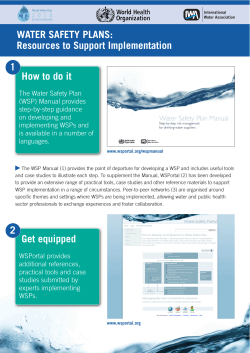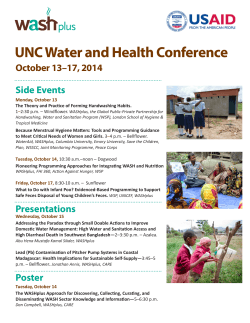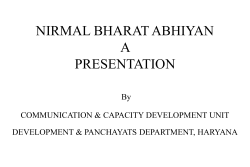
Other issue sheets in this series can be found at
Other issue sheets in this series can be found at http://www.who.int/water_sanitation_health/ dwq/regnet_kit/en/index.html Optimizing regulatory frameworks for safe and clean drinking-water Water Safety Plans: Why are they important and how can their implementation be supported by regulations What are Water Safety Plans and why are they important in the prevention of water-borne disease? Unsafe drinking-water, poor sanitation and lack of hygiene continue to be significant causes of disease in both developing and developed nations, resulting in millions of deaths each year, mainly among children under five (Prüss-Üstün et al 2008). Much of this disease burden is preventable. It is estimated that almost one-tenth of the global disease burden could be avoided by improving water, sanitation and hygiene. 1. Map the water supply system (e.g. make a flow diagram) 5. Review the WSP (e.g. through audits) and develop supporting processes (e.g. through training) 2. Identify the hazards and assess the risks (e.g. through agreed ranking system) WSP cycle 4. Review adequacy of preventive control measures (e.g. through validation, operational monitoring and end-point testing) 3. Implement needed improvements (e.g. following a prioritized schedule) Figure 1. Water Safety Plan (WSP) cycle Adapted and simplified from WSP Manual (Bartram et al., 2009) Poor drinking-water quality is a significant contributing factor to this burden and outbreaks have shown that the conventional approach of monitoring end product water is not sufficient to guarantee safe drinkingwater. Notification comes too late, test results are not timely enough to prevent consumption of unsafe water and sufficient information is not provided to identify the source of contamination (when, why and where it occurred). Recognizing these limitations, the World Health Organization recommends the adoption of the Water Safety Plan (WSP) approach as the most effective way of ensuring the safety of drinking-water. At its core, the Water Safety Plan approach is based on risk assessment, prioritization and management of the water supply from catchment to consumer. Addressing identified hazards is prioritized in terms of their potential risk to public health. Where all risks cannot be immediately addressed, for example due to limited resources, incremental improvements should be implemented systematically over time. The WSP approach introduces processes to validate and verify the effectiveness of management control systems in ensuring drinking-water quality and safety. Optimizing regulatory frameworks for safe and clean drinking-water – Water Safety Plans: Why are they important and how can their implementation be supported by regulations Water Safety Plans are designed for implementation by any supplier of water in any situation or circumstance (socioeconomic, geographical, system type and scale as well as in emergency settings). They can be developed and implemented for use with simple household level supplies on one end of the spectrum as well as with complex utility-managed systems on the other, to: • prevent contaminants and pollutants from entering the source water; • remove particles from the water; • remove chemical and radiological hazards; • kill or inactivate pathogens; and, • prevent recontamination of water during distribution, storage, and handling. Table 1. Water Safety Plans: examples of benefits Better protect public health Maximize existing resources Inform investments Improve water suppliers’ practices Decision-making framework for all stakeholders WSP implementation results in a better understanding of water supply systems and potential risks to public health. The risk prioritization process assists decision-makers at all levels in maximizing public health protection with available resources. WSPs facilitate the identification of appropriate barriers to contamination that do not overly focus on expensive treatment processes, but rather consider a range of options. As WSPs are based on risk assessment of the system and result in a short, medium and longterm investment/upgrade plan, they provide a reliable means for governments, donor agencies and international financing institutes to maximize current and future investments. WSPs help improve water suppliers’ knowledge and management of the entire water supply system, thereby enabling them, for example, to develop more efficient operating procedures and respond faster to potential incidents. Stakeholder cooperation is an implicit part of WSPs; Water Safety Planning therefore facilitates appropriate institutions to collaborate in making well-informed decisions on the strategic, financial, operational and regulatory aspects of drinkingwater quality management. How can the WSP approach be supported by regulations? The WHO Guidelines for Drinking-water Quality recommend that governments encourage Water Safety Planning as the instrument to for the achievement of the guidelines values and the applications of the best practices the Guidelines propose, through the establishment of appropriate regulations, policies and programmes. There is no one way to proceed with supporting WSPs by regulations. Decisions on how to proceed should be taken based on the local context, including existing regulatory frameworks. However, regulatory frameworks should have, as a minimum, the mechanisms to: • support the identification, prioritization and management of risks from catchment to consumer; • empower relevant authorities to support and potentially audit WSPs; and, • clearly define roles and responsibilities and mark the boundaries of institutional mandates as they relate to the WSP approach. Although regulations do not need to reference WSPs by name, they should explicitly promote a WSP or equivalent integrated risk assessment and incremental risk management approach. As for all other regulatory frameworks, appropriate policy and programme support is needed. This includes ensuring that the capacity to support WSPs is built and maintained with all relevant stakeholders, including institutions, through education, awareness and training. Examples of how the WSP approach has been incorporated into regulations WSPs are now being promoted and adopted worldwide to better protect public health by reducing water-borne disease outbreaks as well the burden of endemic water-borne disease. A number of countries have incorporated this concept in their regulatory framework including Australia, Iceland, New Zealand, Nigeria, the Philippines, Singapore, Uganda and the United Kingdom. The Uganda National Bureau of Standards has included in its Drinking (potable) Water Specification a requirement for all drinking-water systems operators to “develop, implement and maintain a Water Safety Plan, taking into consideration the potential risks to the safety of the water from the supply catchments to the consumer.” (Uganda National Bureau of Standards 2008). While this Standard is legally enforceable, the Government of Uganda recognizes the need to support regulations with the appropriate policies and programmes and work is currently underway in this regard. Notably, the National Water and Sewerage Corporation has been developing Water Safety Plans for water supplies under its jurisdiction. In the United Kingdom of Great Britain and Northern Ireland, the Scottish Government’s Private Water Supplies Regulation is reflective of the WSP approach. In the regulation, local authorities have a duty to carry out risk assessments for Type A water supplies (i.e. those that serve 10 or more cubic metres of water per day, 50 or more persons, or is supplied or used as part of a commercial or public activity) (The Scottish Government, 2006). Local authorities have discretionary powers for Type B water supplies (i.e. private water supplies for human consumption that are not Type A water supplies). Furthermore, the regulation also provides specific direction on how to carry out risk assessments, specifically documenting and describing the supply (e.g. catchment, hazard assessment and risk characterization), identifying how risks may be controlled and establishing verification procedures. Education and awareness creation materials and tools, as well as a grant scheme, support the implementation of this regulation. Optimizing regulatory frameworks for safe and clean drinking-water – Water Safety Plans: Why are they important and how can their implementation be supported by regulations Further Reading Key References WHO (2010). Think big, start small, scale up: A road map to support country-level implementation of Water Safety Plans. Geneva, World Health Organization. (www.who.int/water_sanitation_health/ WHS_WWD2010_roadmap_2010_10_ en.pdf) Prüss-Üstün A, Bos R, Gore F, Bartram J. (2008). Safer Water, Better Health, Costs, benefits and sustainability of interventions to protect and promote health. Geneva, World Health Organization. WHO (2010). WSPs: managing drinkingwater quality for public health A brief on the benefits of shifting to a WSP approach. Geneva, World Health Organization. (www.who.int/entity/water_ sanitation_health/WHS_WWD2010_ advocacy_2010_2_en.pdf) Uganda National Bureau of Standards (2008). Drinking (potable) Water – Specification. US 201:2008. Government of Uganda, Kampala, Uganda. The Scottish Government (2006). The Private Water Supplies (Scotland) Regulations. Scottish Statutory Instrument 2006 No. 207. United Kingdom of Great Britain and Northern Ireland. WHO (2010). WSPs: resources to support implementation. Geneva, World Health Organization. (http://www.who.int/water_ sanitation_health/WHS_WWD2010_ resources_2010_2_en.pdf) WHO (2009). Water Safety Plan Manual: Step-by-step risk management for drinkingwater suppliers. Geneva, World Health Organization. (www.who.int/water_sanitation_health/ publication_9789241562638/en/) © World Health Organization 2011 Water Safety Portal (WSPortal) (2010). (www.who.int/wsportal/en/) Issue sheets in this series, Drinking-water: Optimizing regulation to protect health, were developed together with the International Network of Drinking-water Regulators. More information on this Network can be found at www.who.int/water_sanitation_health/dwq/RegNet/en/index.html
© Copyright 2025













